MobyGames has completely cleared my queue of new game submissions. It helps that I have only been processing screenshots for existing games for the past week or so. Here are the latest 2 new entries from this blog:
Author: Multimedia Mike
Spycraft: The Great Game
Some readers have recommended that I lay off the interactive movies, for the sake of my own sanity. I thought about it. But I see this list of known, unprocessed I-movies staring back at me from the surface of my gaming command center and I just can’t bring myself to abandon, or even postpone, the mission at this point, no matter how much it might be wearing on my psychological and emotional well-being. That, my friends, is commitment.
Besides, the next game on the I-movie roster — Spycraft: The Great Game — is one whose movie sequences I have perused before using a video decoder I helped reverse engineer and re-implement. Thus, I know it’s not all bad. In fact, the movie sequences are very good. Further, when I actually played the game this evening, I realized that it’s not pure I-movie but actually places heavy emphasis on some very unique puzzles. For that, I have placed this game in the puzzle games category in addition to the I-movie category, and I think even the I-movie category is iffy.
You play some CIA guy. There’s a big international event brewing. You are summoned into the director’s office to be on a team to investigate a new international crisis. But first, there is training. Generally, these are unique puzzles with a little faux FPS-type action thrown in for good measure. For example, the first training exercise is to use an image enhancement device to make out the license plate on the following picture:
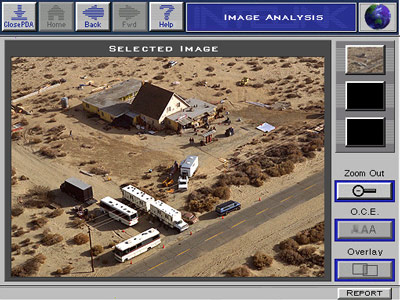
The game features a lot of convenient little gadgets. Between two of the training puzzles, your tutor shows you a camera that operates on film but explains that it has backup, low-resolution images stored in a digital chip. What’ll they think of next? (This game was published in 1996.) Actually, now that I think about it, that device would work better for espionage applications (or would have worked better before film cameras were more or less crushed by digital counterparts) if it operated on more of a steganographic principle and allowed a knowledgable operator to snap innocuous photos on the film and secret photos on the digital chip.
The game is filled with tools that are so sophisticated that it’s a wonder why they need human intervention at all. But there wouldn’t be much of a game in that case. Here’s another interesting puzzle:
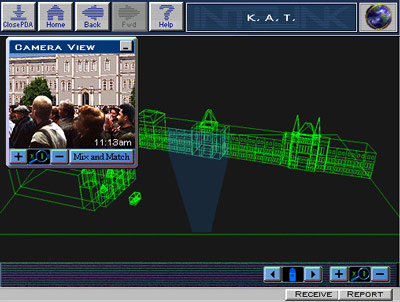
This is the K.A.T.– Kennedy Assassination Tools. This program uses a camera panorama to reconstruct a 3D wireframe model of an assassination site. You need to find two places on the scene where the bullets impacted. Then, use the tool to draw a trajectory to figure out where the round was fired from. Use the panorama camera view to find the suspect and then use the suspect ID computer to put together a computer sketch of the suspect. Finally, you can ask the computer to perform a search for possible matches based on the sketch.
There are lots of information resources in this game, including your PDA and your computer which both have access to impressive databases. Among other things, you have an org chart of your immediate superiors and reports. Here’s the dossier for one your subordinates:
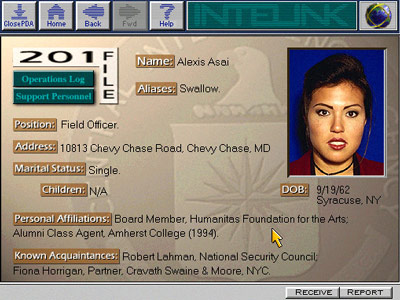
I thought the game designers were taking things pretty seriously until I saw where she lived. Chevy Chase, Maryland. Come on, Spycraft, what do you take me for? But on a whim, I googled. Well, I’ll be– town of Chevy Chase, dot org. In fact, there does exist a Chevy Chase Blvd. in Chevy Chase, MD (though no Chevy Chase Road). I can go to bed knowing I learned something new tonight.
The answers to the puzzles always seem to be multiple choice. This is fortunate in most cases, such as the license plate puzzle. Rather than actually having to make out the grainy characters on the plate, the solution is obvious out of the three given. However, the choices grow more bountiful later in the game. And don’t you dare guess. If you get the wrong answer too many times, the director reassigns you to the CIA World Factbook division, which I’m guessing isn’t thought of very highly inside the Agency, or at least not in this game’s story arc. Here’s that particular game over video:
You know, I should start listing the games from this experiment that I have really enjoyed and that I want to revisit someday when this experiment is over, or when I simply need a break. This game definitely makes the cut.
See also:
Quantum Gate
Ohhhh… this is really starting to hurt. Okay, let’s go: Quantum Gate. This is — you guessed it — another interactive movie genre video game. This one was published by an outfit called Hyperbole Studios, reportedly all the way back in 1993. They subsequently produced a sequel and yet another title. I wouldn’t have expected them to have lasted beyond 1995. But it seems that they were responsible for The X-Files Game as late as 1998. They still have a web presence as of this writing, though the latest date seen anywhere on the site is 2002.
I was going to upload their propaganda video (their term, not mine) to YouTube but screw it; I’m not even going to dignify it. I remember watching this little promotional piece years ago when I first procured the disc. It spoke as if I-movies were going to revolutionalize the industry and that Hyperbole’s titles were watershed events in the history of computer gaming. The final insult was when the CEO of the company, one Greg Roach, was named the Steven Spielberg of multimedia (attributed to The Houston Chronicle, in case you ever need to discredit that newspaper).
You might think that given the vintage of this title, I should cut it some slack. Think again. Let’s walk through my brief playing experience. There is a short company logo animation followed by the title animation, then the menu shows up. Note that if you ESC through the first two animations, none of the menu options are clickable besides “Quit”, which seems to fit right into my plan. Still, I went the long route for the sake of screenshot recon. There is a screen that explains the complex controls. Hint: If the mouse takes the shape of a hand pointing left, you can click the mouse to move left.
Jumping into the start of the game:

QG, you had better not dare tell me that I’m humanity’s last hope. Well, to its credit, the intro didn’t actually claim that, but I think it’s more or less implied. I mean, what game tells you that some other guy is responsible for the fate of earth and you’re just running support?
Anyway, and from what I can put together (it’s not the most coherent story), earth is eminently doomed because of pollution — shame on mankind, as always — and the U.N. has a plan to do… something, I’m not entirely sure. You’re part of some military group that has to launch through space in a special gate (this might be the game’s eponymous gate) to another planet far away. You then attend a poorly managed briefing where someone explains the classified fate of earth. Then, a slightly senior officer explains how it’s going to be your job to help secure the planet from the race of bugs that currently inhabit it. Or something.
Look, I’m getting really tired of trying to sort out these bastard stepchild sci-fi stories. Let’s move on to characters, who I’m sure the creators were quite proud of. First, there’s your character, a military guy — military vanguard or some such — who walks around in a perpetual state of disbelief and whose most common line of dialogue happens to be more or less the same as South Park’s Mr. Slave character. Then there’s this character:

He comes off as a Vin Diesel wannabe, which is strange since Vin Diesel wasn’t a star until well after this game was made. He makes life miserable for everyone else in the room with his antics and interruptions. Thing is, his material is, far and away, the most interesting part of the proceedings. I don’t really want to spend anymore time on characters. No, wait, here’s one more character I always get a kick out of gazing upon– Dr. Scientist Lady, the one who invented the Quantum Gate:
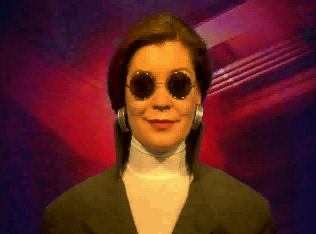
Okay, about those “proceedings” briefly referenced above, I will admit that Quantum Gate has a unique cinematic style while stipulating that different is not always necessarily a good thing. Most of the game (that I saw) showed cinematic sequences (that you can’t skip) where there was a wide, letterbox-style picture depicting the people who were presently talking. Video images of that person talking are overlaid on the picture. Sometimes, one video finishes and another video — of the same person — emerges on a different part of the picture and takes over.
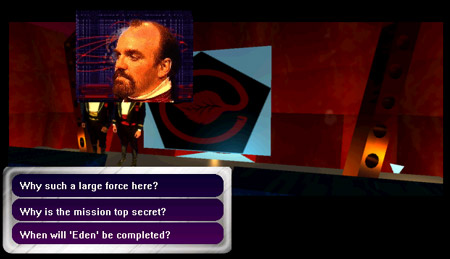
As you can see from the above screenshot, you are occasionally granted the opportunity to have your character interject something. This is apparently of little consequence, but the game throws you an interactive bone anyway. It’s also much worse than a screenshot can possibly convey. Imagine the most painful mumbo-techno-jumbo-jargon-packed Star Trek episode you ever watched. Now imagine not being able to fast forward it or even turn off the television.
The whole initial briefing implies that there will be combat with some alien bugs. Eventually, I get to try my hand at a simulation of such combat. The combat consists of a pre-rendered FMV sequence where some vehicle roves across alien terrain looking for the alien bugs and locks on. From there, I have to press the space bar to fire on them. I could never get past the second bug. My loss.
That’s it. It’s all over for tonight. But as I look at my list of unprocessed I-movies, I already know that I haven’t seen the worst yet.
Phantasmagoria
A week ago, I wrote out a list of all the unprocessed games in my pile that are known to be interactive movies (there might be undiscovered I-movies left in the pile as well), in an effort to just get them out of the way first. Next up– oh, dear, it’s Phantasmagoria, Sierra’s beloved 7-CD I-movie classic. I wasn’t sure if I should bother with this game because I wasn’t sure which version I had. Only the DOS entry needs screenshots. It turns out that the same game has versions for DOS, Windows 3.x, and Windows 95, and that they all look the same, further advancing my theory that these I-movies are not especially complicated, programmatically. So I embark on an effort to collect a nominal screenshot set for MobyGames, and perhaps revise the entry’s description. So, DOSBox, don’t fail me now.
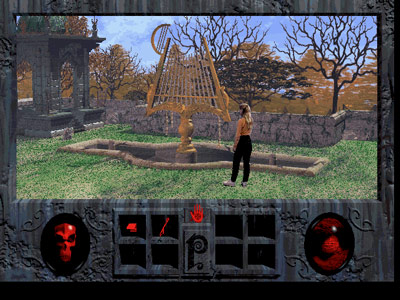
Phantasmagoria is the story of a young wife, Adrienne, and her photographer husband, Donald, who have just set up camp in an old castle. The game’s manual encourages the player to ask a lot questions. Okay, here’s one — how exactly does a photographer afford a castle? I’m assuming that the joint is a family heirloom of some sort. Anyway, it doesn’t take long before the nightmares start for Adrienne, and bad things start happening in the castle.
Everything works smoothly and I capture the screenshot set I was after. Plus, I finally got to experience the true horror of the game. Well, at least I got as far as one terrifying cutscene, where our heroine lays on a bed that cops a feel:
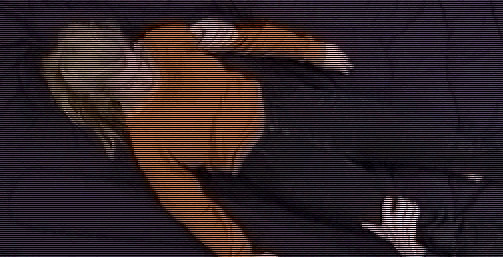
Contrast the above screenshot with the first one. It’s interesting to note that the game always goes to interlaced mode when it’s cutscene time. Not interlacing, precisely, but the original video is doublesized in the horizontal direction and every other line is black, or left undrawn, to save rendering time.
This isn’t the most obscure game on the planet, so I didn’t feel much need to spend too much time investigating it. Plus, I honestly wasn’t that interested. Here are some other random notes I jotted down along the way:
- The game installs to the default directory of c:\sierra\scarydos. Novel.
- The game features a friendly skull icon (seen in the first screenshot on the lower left part of the screen) who identifies himself as the hintkeeper. He helps you out.
- I found a walkthrough that lists 277 easy steps to completing this game. If you have that much patience. Anyone up for a speed run?
- The game takes place in or near the town of Nipawomsett, which I’m convinced must be an anagram for something. “pastime town”? “spa time town”? “impotent saw”? “want semi pot”?
In The 1st Degree
I have no shortage of interactive movies yet to process. Today’s game is In The 1st Degree developed by Brøderbund, popularly known as that software company with the weird ‘o’ in its name. This is the third I-movie in a week that has referenced San Francisco. D made a completely superfluous reference to the city. Beyond Time showed us a brief pan of downtown SF to assure us that the game is supposed to begin in a Frisco museum. But In The 1st Degree is entirely set and filmed in the city by the Bay. As a current Bay Area resident, I can personally vouch for the authenticity of this game and I had a good time figuring out where the characters were presently situated in the tiny (by American standards) city. Why, here’s an authentic sequence driving down a famous San Francisco hill past a famous S.F.-style cable car:

Someone’s Dead. Someone’s Lying. Can You Prove Murder One? That’s the game’s tagline. There was a kerfuffle between a Frisco artist and a Frisco art gallery owner and the owner wound up shot to death. You play the district attorney and your ultimate goal is to get the artist convicted in court with murder in the first degree. Not second degree, not manslaughter, and certainly not an acquittal. You want murder one.
The first part of the game deals with reviewing documents, dossiers, and crime scene photographs. You drive around town and interview the witnesses at their homes or their places of commerce. And you also review the tapes of the witness interviews conducted by the police inspector:

As you can see, you get to review the tapes at your Pier 5 office, overlooking the Bay, Yerba Buena Island, and the San Francisco-Oakland Bay Bridge. The game’s writer(s) knew San Francisco and it shows in the characters’ dialogue which, BTW, is extraordinarily well-delivered by the standards of the I-movie genre. The second part of the game is where you go to trial with the evidence you have gathered and secure the most severe conviction you can. I didn’t get that far but I can honestly say this is the best I-movie I have seen to date and one that I would actually like to play again, perhaps to completion.
I knew that there was something different about this game when I first studied the QuickTime multimedia files some years ago. In The 1st Degree is fond of using the time-honored exposition-by-newscast narrative device where the story unfolds from the lips of television news anchors and correspondents. I would upload some samples to YouTube but YouTube has the worst time converting QuickTime files while retaining accurate A/V sync. At the beginning of the game, you (the DA) are sitting at home (which looks to be located in Noe Valley, if I were to guess), eating dinner:

What does a successful (we hope) DA eat? Looks like celery, cottage cheese, cookies, and a pastry. But about the main course on that plate — why, that looks for all the world like one of many fine Chef Boyardee pasta-in-a-can products. And — wow — that’s one honkin’ big cell phone, but this was a 1995 game. Ah, how far we’ve come.
Some interesting technical trivia about the game: Even though my computer display is set to use 1280x1024x32-bit color, the game complained that I needed at least 256 colors. It worked fine when I demoted the video mode to 800x600x16-bit color (8-bit isn’t even an option). Also, the game uses MIDI music to great effect. Even though the game claimed not to recognize my MIDI device, the music played and sounded great.
See Also:
At MobyGames:
First February Entries
MobyGames has been on an approval roll recently (it helped that I was on an entry roll immediately preceding). Here are the latest new game entries, courtesy of this blog: